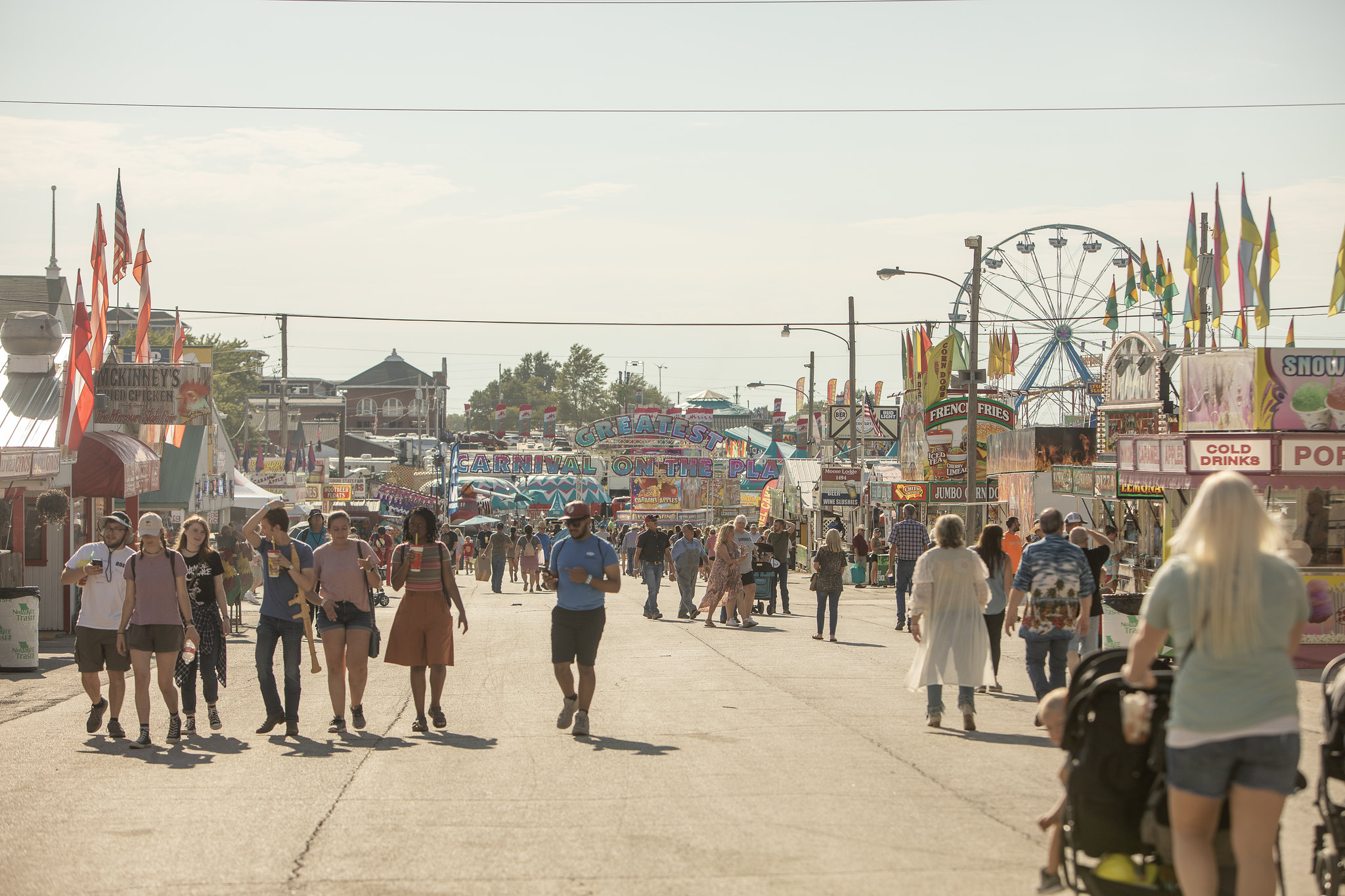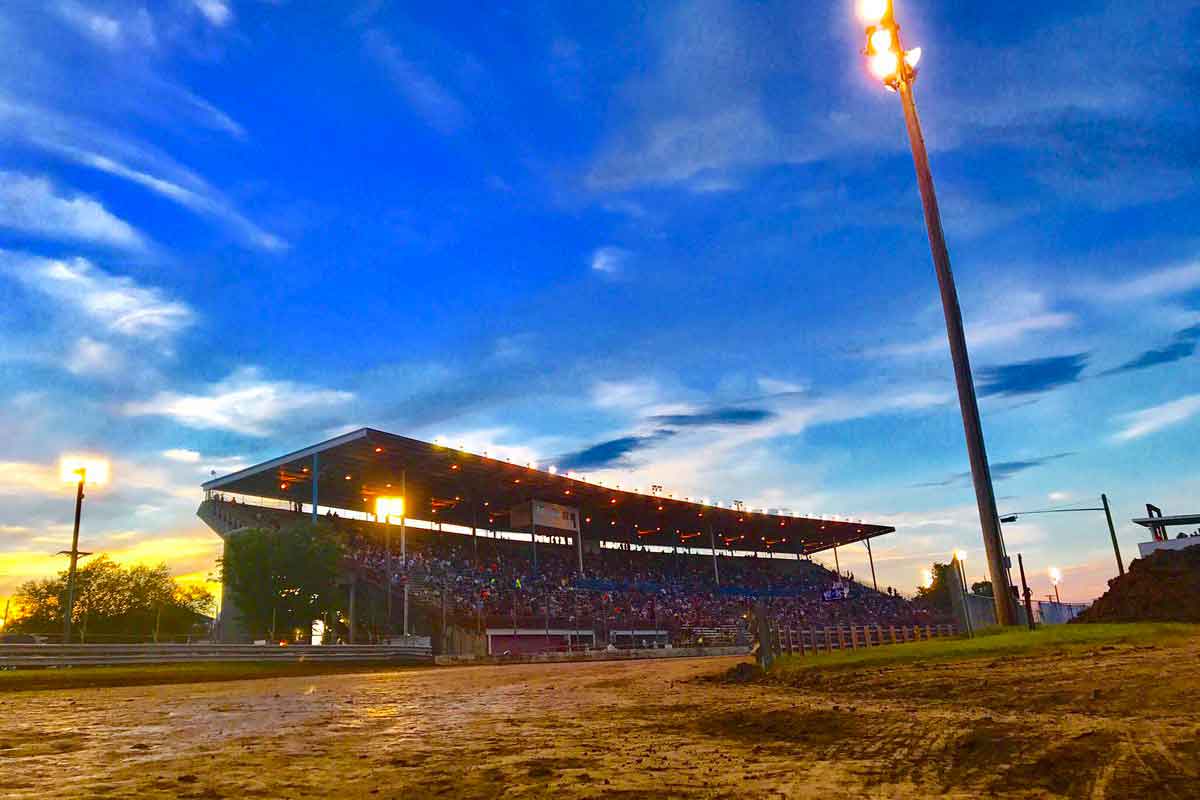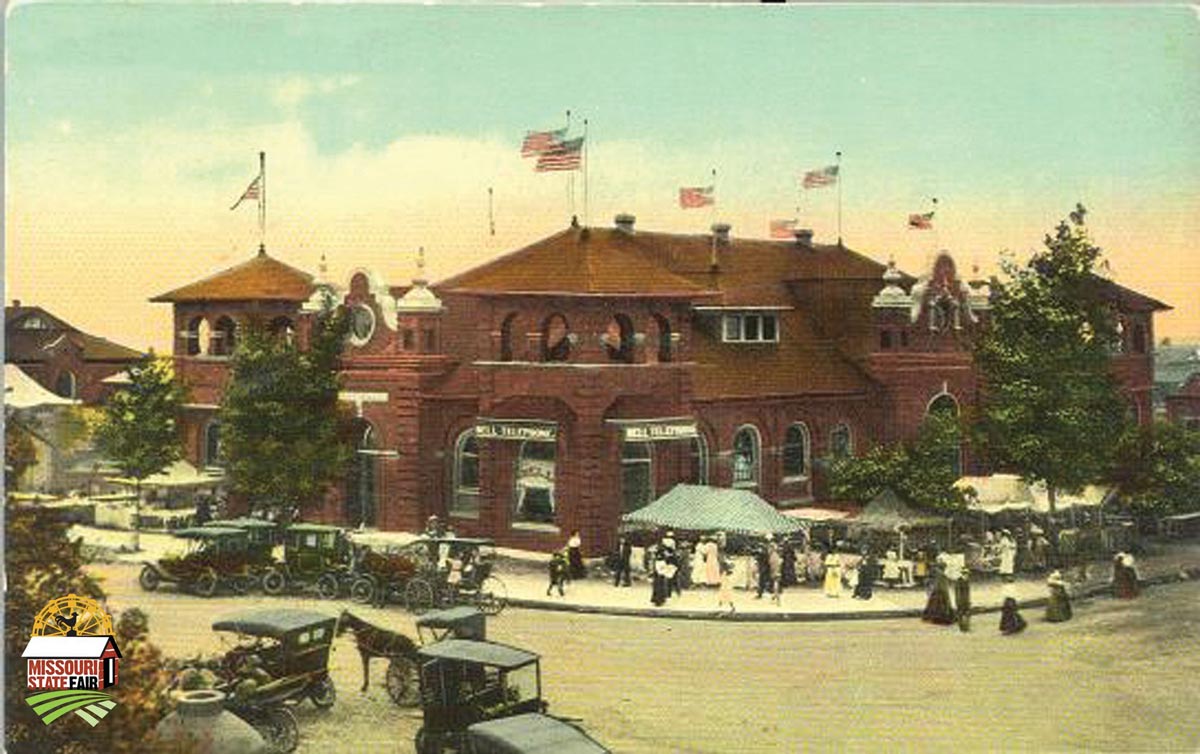We are celebrating 50 years of Missouri Life. Our first story about fairs was in the July/August 1973 issue. Our writer revisited fairs from around the state to see what has changed and what has stayed the same. Find out which fair is famous for fish sandwiches.
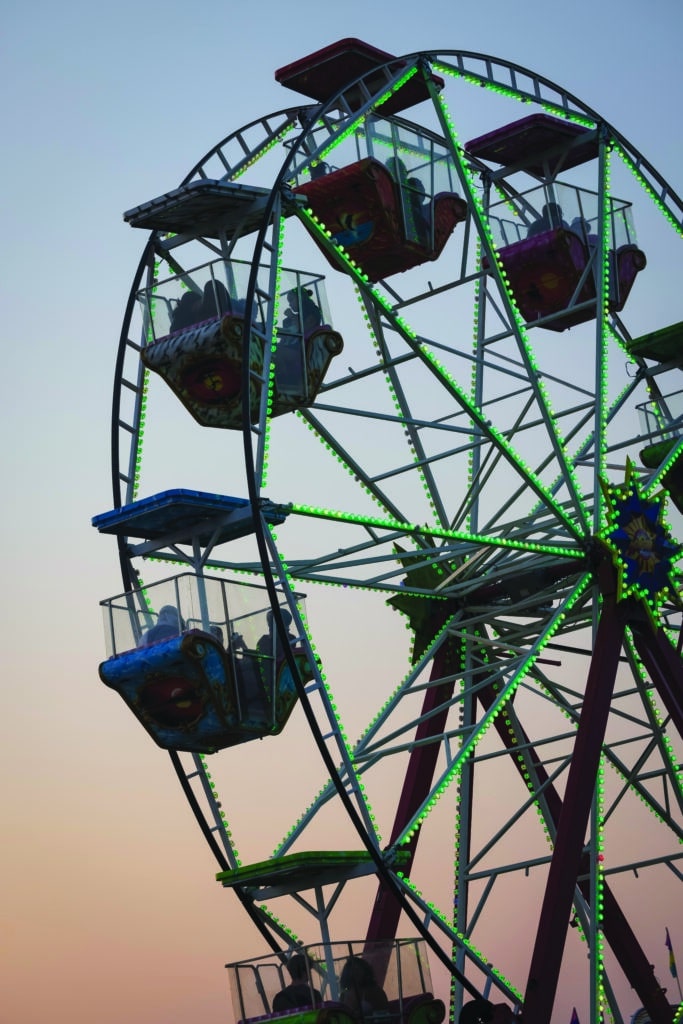
Photo by Notley Hawkins.
By Susan Atteberry Smith
50 Years Ago at the Fair In our July/August 1973 issue, writer Walter Kaufmann recalled his first visit to the fair. He talks about the pens full of cows and pigs, the persuasive vegetable peeler salesman, the thrilling carnival rides, and foot-long hot dogs washed down with ice-cold root beer. So much about our world has changed since then, but we are still entertained by the simple, wholesome traditions of the fair. Walter’s story is one that could have been written today. Read his 1973 essay here.
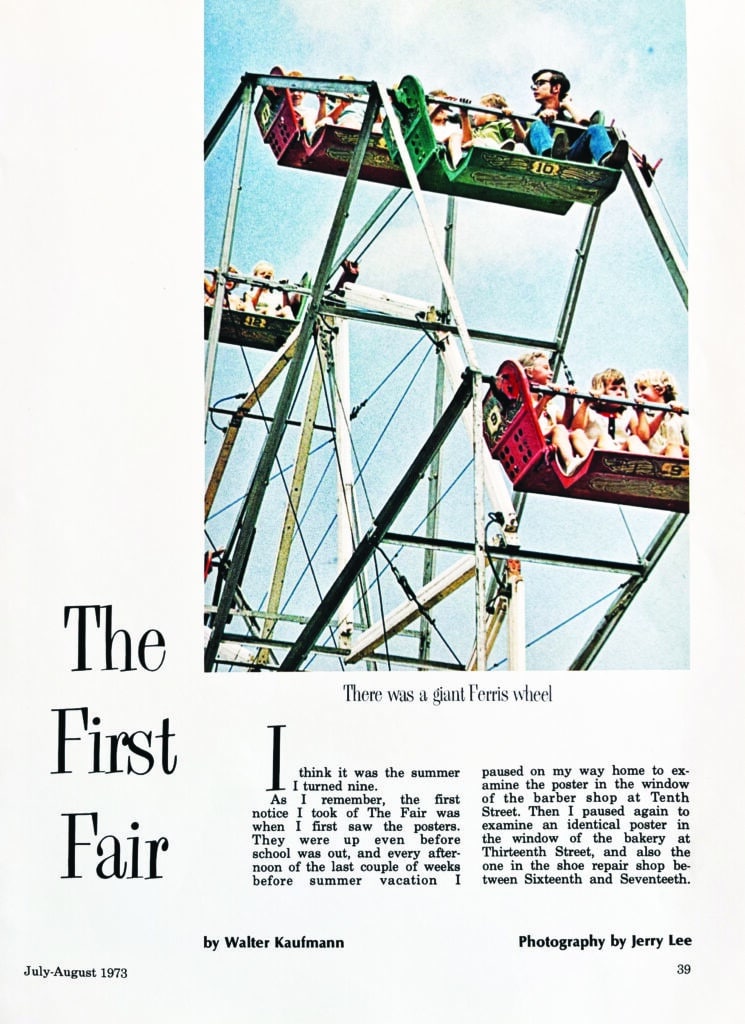
Local fairs are a summertime tradition for generations of Missourians.
It’s a sunny Saturday afternoon in early September, and the heat is stifling at the Maries County Fairgrounds. Robin Kleffner is sitting under a shade tree and waiting for her 11-year-old grandson to take his turn in the kids’ tractor pull competition.
The annual county fair has been a big event on the family calendar since the Vienna native was a child, and Robin isn’t about to stop attending it now, no matter how high the temperature soars. “I feel like if I don’t come, I’ve missed something,” she says. Thousands of other loyal fair goers across the state might say the same as exhibits and livestock shows, carnival rides and rodeos, and food trucks and tractor pulls bring fairgrounds to life this summer and fall. Fanning away the heat or braving an unexpected downpour, they’ll hope for blue ribbons and heartwarming reunions.
And, while catching up on the news with seldom-seen friends, they’ll stand in line for corn dogs and funnel cakes—or, if they visit the East Perry Community Fair in Altenburg, the famous grilled cheesesandwiches that hungry guests have come to expect.
By October, an annual fair will have taken place in more than half of the state’s 114 counties. Whether they draw thousands to pro rodeos and headliner music acts or only a hundred or so to youth livestock and 4-H exhibits, county fairs still celebrate simple, old-fashioned fun and a rural way of life.
THE LONGEST RUNNING FAIR
According to the State Historical Society of Missouri, most fairs got their start as harvest and agricultural exhibitions, a few as early as the last half of the 19th century.
Horse races were the main attraction at some early fairs. It wasn’t long before fairs across the state fostered competition in other arenas. The fair is where neighbor went up against neighbor in cordial contests to find out who could boast the best livestock, agricultural and horticultural products, baked goods, needlework, and more.
Many of Missouri’s county fairs have skipped scarcely a year since they started, not counting interruptions from wars and the COVID pandemic.
The Platte County Fair, just north of Kansas City in Tracey, started in 1858 and came to a halt three years later with the start of the Civil War. It resumed in 1863, and despite drought, flooding, the Great Depression, and even a grasshopper plague in 1875, it has kept going ever since. During the pandemic, when most fairs were canceled, shareholders of the privately owned fair were determined to hold some kind of event and to hold onto its claim to fame as the longest running fair west of the Mississippi River, board member Laurie Lewis says.
“Everybody had their masks on, and it was hot, but we were able to have the livestock shows,” Laurie says. She has missed only one year of the fair herself. “And that was the year I gave birth to my twins.”
Laurie, who showed a poodle at the Platte County Fair when she was two and went on to show cattle, chickens, dogs, ducks, horses, rabbits, and even a turkey, understands the agricultural importance of fairs to kids.
So do participants at other long-running Missouri fairs.
At the 85th Webster County Fair last June in Marshfield, Les Hartman watched his three-year-old daughter, Emmerson, win a blue ribbon for showmanship as she led her white Katahdin sheep, Tiki, around a livestock arena. The second youngest of five of Les and Audrey Cantrell’s children, it was Emmerson’s second year showing animals alongside her older brother and two sisters.

County Fair.
Photo by Susan Atteberry Smith
Growing up on a farm just outside Marshfield, Les belonged to the high school’s Future Farmers of America club and raised cattle. He was taking animals to the fair from the time he was Emmerson’s age.
Today, Les’s children are growing up on a farm only a couple of miles from his childhood home, and he wants them all to have the experience of showing livestock at the fair that he once enjoyed. It gives kids a sense of ownership and success, he says.
Across the arena, Joni Day shares Les’s sentiments.
“They’re not just feeding livestock; they have a goal,” Joni says of her own four children and a niece, who are showing sheep and calves. Ribbon-winners receive cash prizes, she explains.
Across Missouri, those agricultural traditions can go back generations, according to State Fair Director Mark Wolfe. At the Missouri State Fair in Sedalia, he often visits with grandparents and even great-grandparents who used to show livestock there.
“It’s not uncommon for us to run into people who are in the swine barn watching the kids show, and it’s the great-grandparents,” Mark says. “We get a lot of that.”
In the Platte County Fair’s Floral Hall, visitors can admire arrangements of homegrown flowers as well as baked and canned goods created with homegrown fruits and vegetables. They can also watch quilters demonstrate their craft and view handmade quilts, Laurie says. In the 4-H building on the grounds, attendees can view photography and crafts by kids and adults alike, she says.
PIGS IN A BUCKET
Fair goers expect to be entertained, of course, whether they’re kids who can’t wait to climb aboard carnival rides or teens and adults anticipating a rodeo or a concert by a popular performer.
For smaller fairs on tight budgets, hiring a well-known pop or country artist to perform may not be financially feasible, according to Missouri Association of Fairs and Festivals Executive Director Randy Fryman. The Potosi native is also president of the Washington County Fair.
Fortunately for fair organizers, some of the most popular attractions are also budget-friendly.
The truck and tractor pulls are the biggest attractions at the Webster County Fair, according to fair manager Kevin Cantrell, yet at many fairs it’s the old-fashioned fun—not to mention the food—that counts.
At the Maries County Fair in Vienna, part of that fun is a cornhole tournament for adults and a greased pig contest for kids. Both pigs and kids are a blur as the former—coated in slippery dish soap—scuttle squealing away from their pursuers, who kick up plenty of sawdust as they try to be the first to catch a pig and plop it into a plastic bucket in the center of the arena.
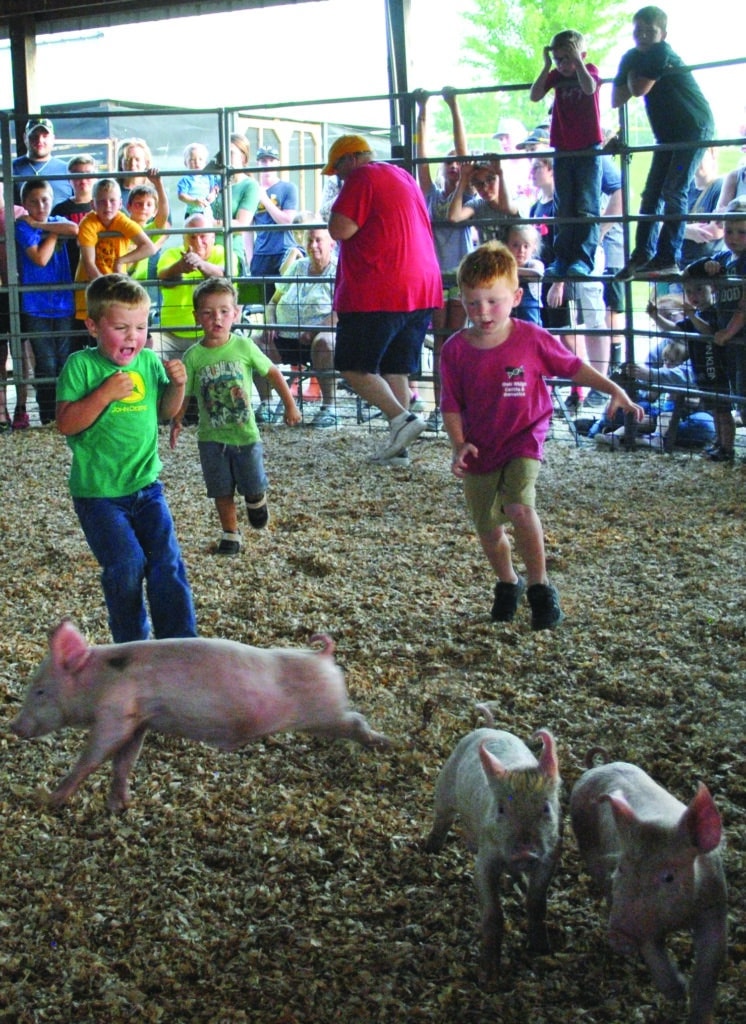
Photo by Susan Atteberry Smith
The stands are packed with family and fans who are there to cheer them on. Even at the state fair, where nationally acclaimed acts such as Tyler Hubbard, Lainey Wilson, Nelly, and Riley Green are lined up to entertain this year, Mark Wolfe says he would never want to be the guy who cancels the pig races.
“We’ll always have to have pig races,” he says. “It may be the same thing every year, but you can hardly find a place to watch it when the show comes on.”
Swine may salivate for an Oreo cookie—the reward used to train a pig to run—yet even humans will anticipate tasty treats weeks before festivities begin.
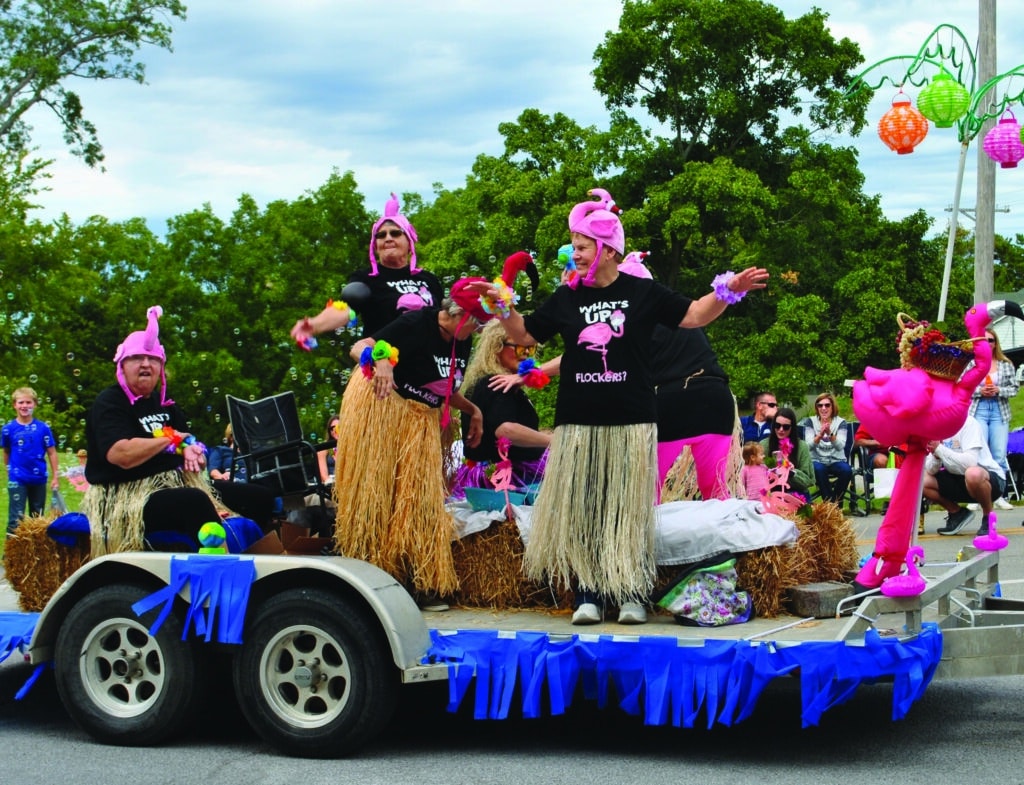
Photo by Susan Atteberry Smith
At the East Perry Community Fair, it’s the famous grilled cheese sandwiches. At the Platte County Fair, it’s a kraut burger. And at the Washington County Fair, Randy Fryman says, “I hate to say it, but we’re known for a fish sandwich.” Only the Lions Club members who run the fair know the secret that makes that sandwich so delicious, Randy says. All he knows is that people talk about it long before the August fair. “Everybody says, ‘We can’t wait until the fair gets here to get your fish sandwich.’ ”
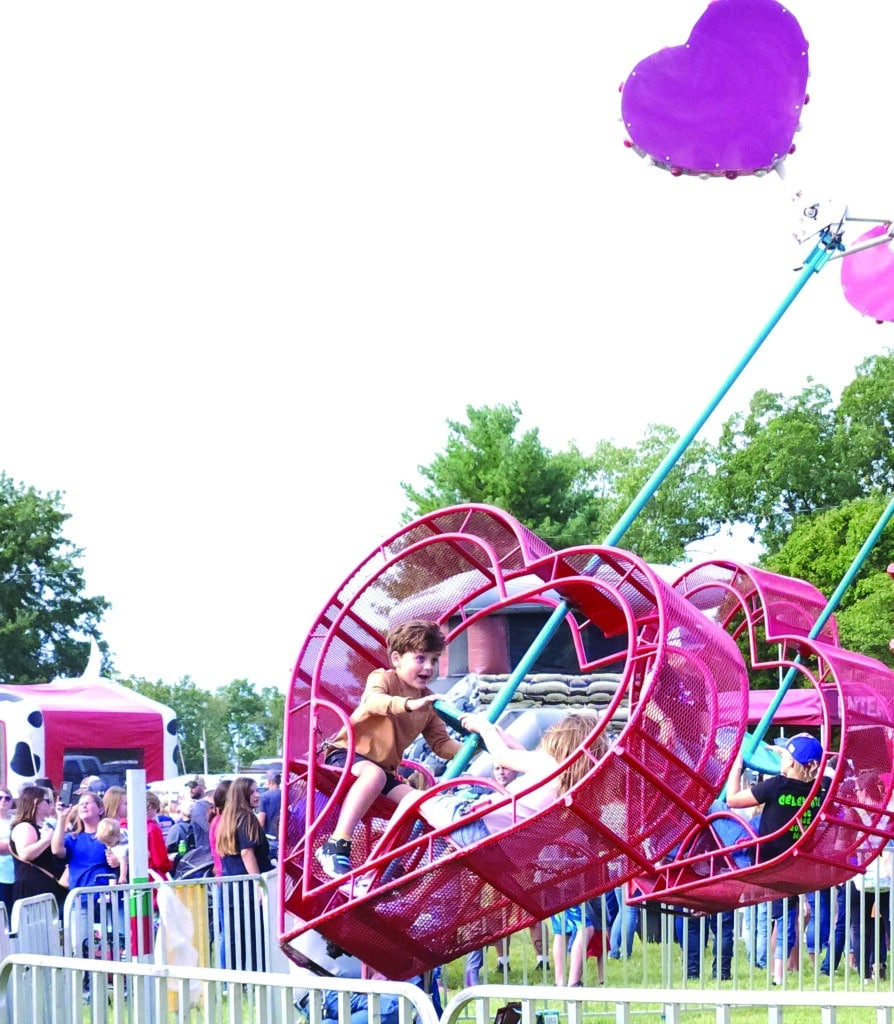
Photo by Susan Atteberry Smith
HOW TO PUT ON A FAIR
Whether it’s a local club or a fair board in charge, organizing so much fun for so many people takes work—“a lot of hours and effort,” according to Fred Eggers, publicity chair for the East Perry Community Fair.
Dubbed “The Best Little Fair in the Land,” the county’s free fair has been held since 1937 in Altenburg, a community with only 339 residents. Come fair time in late September, thousands converge on the town. In 2021, a year after the Perry County fair was canceled due to the pandemic, Fred says attendance topped 30,000 during the two-day event.
With jobs that include directing traffic, driving shuttles to and from parking spaces, and just making sure everything from concessions to livestock shows runs smoothly, the fair relies on around 300 volunteers each year.
A core group of fewer than 20 community members keep it going, Fred says, and most tend to keep the same job year after year. The Farrar native and retired accountant has served as publicity chair since 1981.
“That’s the way jobs go here,” he says.
Over in Platte County, Laurie Lewis expects to be a volunteer for many years to come. “It seems like once you’re on the board, you never leave,” she says, laughing. “I haven’t known anyone to be fired yet, and I’ve tried a time or two.”
Last fall, the Maries County Fair was in full swing around Colleen Barnhart as she manned an information tent as a crowd of hundreds milled about among attractions like carnival rides, the cornhole tournament, and the pig contest.
Yet the year after the pandemic hit, with only one community member left on its board, the fair almost didn’t mark its 75th anniversary. “Several of us got together and decided we were going to try to have the fair,” Colleen says. “The community appreciated that they were going to have a fair of some kind.”
Kudos from the community go a long way with the volunteers who toil through hot Missouri summer evenings at the fair. One of those grateful guests is Tyler Wunderlich, a regular at the East Perry Community Fair.
“It’s a great way for families to get back together, for the community to come back and visit each other,” he says. “And like the old German Octoberfest, to celebrate what the good Lord has given us in harvest. That’s what it is.”
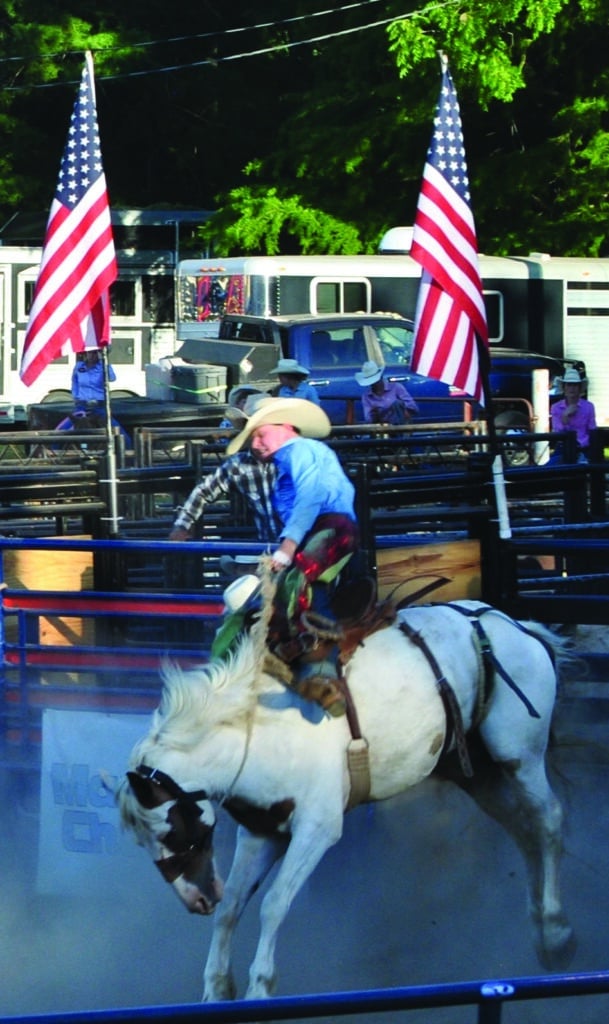
Photo by Susan Atteberry Smith
THE FAIREST OF THE FAIRS
Our in-the-know Missouri Life ambassadors share favorite things about their local fairs.
Cole Camp Fair (Cole Camp, September 7–9)
Ambassador Debbie Noland says the Cole Camp Fair in Benton County is famous for elaborate parade floats. “It is typical for a single float to contain 15,000 to 25,000 handmade tissue paper flowers.”
Laclede County Fair (Lebanon, July 10–15)
Ambassador Mike Boggs reports that his county’s fair is known for its cornhole tournament, antique tractor pull, and egg carton show.
McDonald County Fair (Anderson, July 20–22)
Ambassador Barb Ittner says “the community really supports the youth during livestock auctions.” And there’s a scarecrow contest!
Nodaway County Fair (Maryville, July 13–15)
Ambassador Holly Cronk says her county is famous for holding its fair around the Maryville town square.
Osage County Fair (Linn, July 13–15)
Ambassador Susan Sundermeyer says kids love the bubble gum-blowing contest, Hula Hoop contest, and turtle races.
Phelps County Fair (Rolla, August 3-5)
Come for the spouse-calling contest, mullet contest, and barn dance.
Pike County Fair (Bowling Green, July 25–29)
Ambassador Jim Ross says “the bloomin onion” at his county’s fair puts Outback to shame!
BET YOUR BUTTER YOU DID NOT KNOW THIS!
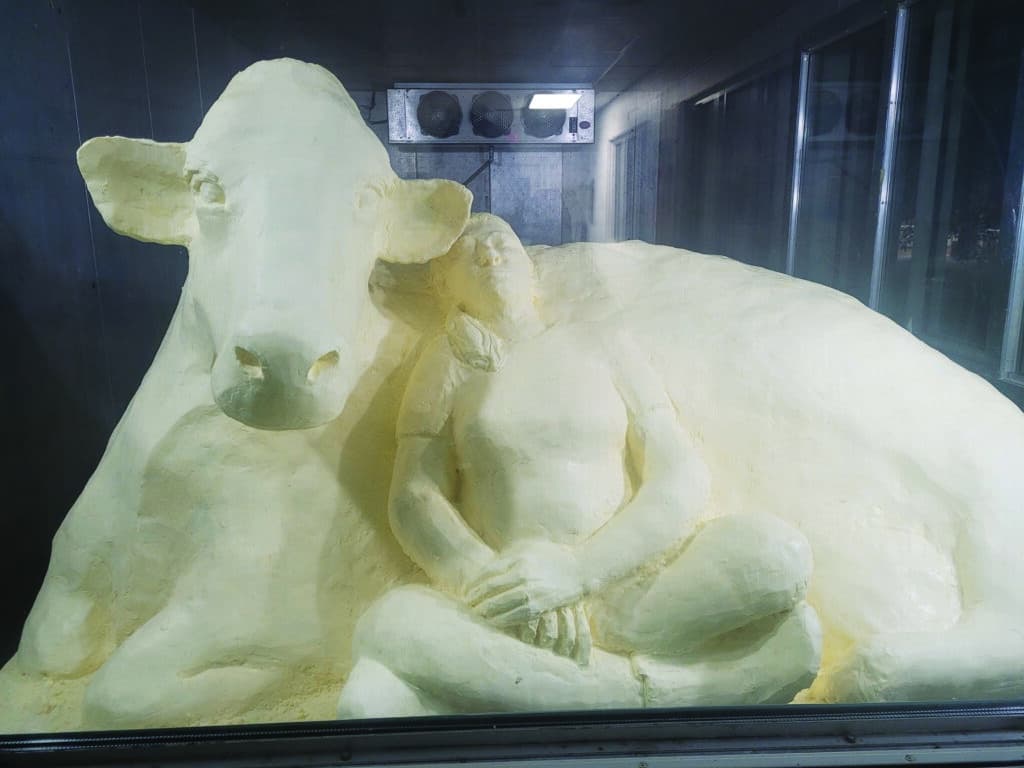
ONLY AT THE FAIR
Meet Butter Cow Artist Angela Weis
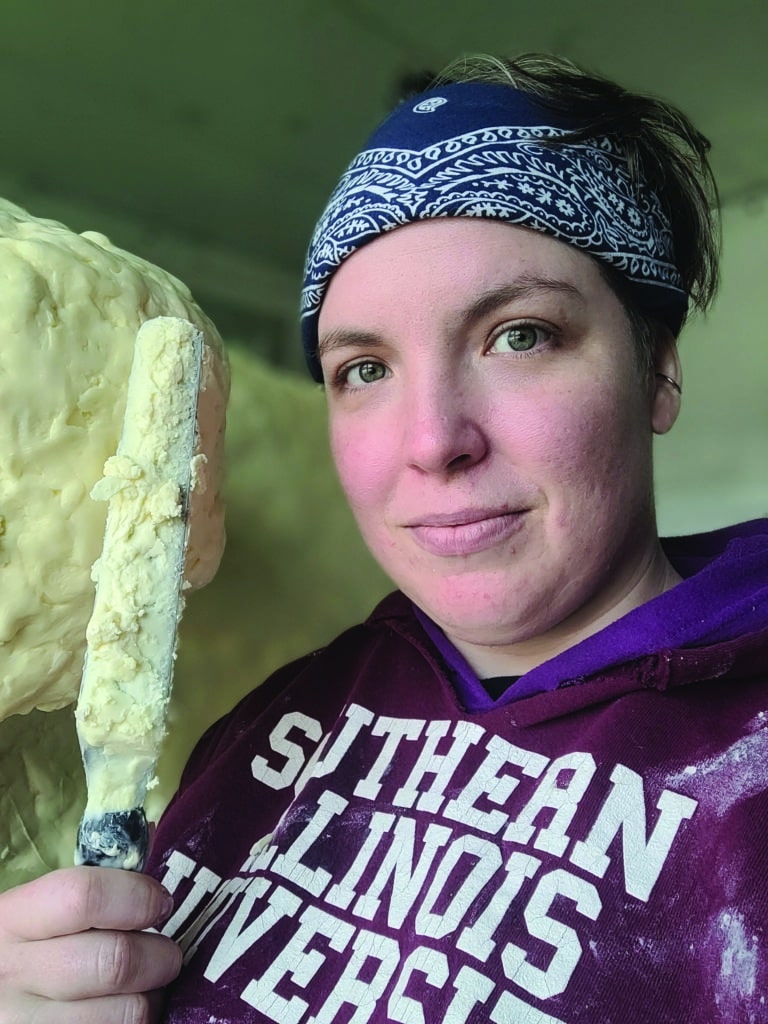
STORY BY Diana West
In the late 19th and early 20th centuries, butter art became a popular attraction at state and national fairs. Butter sculpting, especially of cows, started in the 1920s at the Missouri State Fair but not on a regular basis. Then, in 2005, Midwest Dairy stepped up to sponsor an annual butter sculpture. Since then, four different artists have taken turns at creating cows made of butter for the delight of state fair visitors. Angela Weis is the most recent member of that group.
Angela is an artist and teacher at the St. Louis Artists’ Guild, and she is approaching her third year as butter sculptor. She landed the job when she was asked if she knew anyone who could sculpt a butter cow. “I could do that!” she said.
She had sculpted in several mediums, including clay and terra cotta, but never in butter and never featuring cows. Angela focused on human anatomy in college. “It’s not that big a leap to cow anatomy,” she says, “just different proportions.”
Angela spent months studying cow physique. She watched YouTube videos of Sarah Pratt, a master butter sculptor, to learn Sarah’s technique and has files of cow images from different angles.
The first year she sculpted at the fair was 2021, when the theme was the bicentennial of Missouri statehood. “I based the butter sculpture on a photo from the 1910 state fair that featured a boy showing his cow.”
She admits there was a learning curve. The second morning, when she walked into the Gerken Dairy Center’s glassed-in room, she saw the nose, udder, and one side of the butter cow plopped onto the floor. She turned the temperature down from 40 degrees to 35, bundled up in warm clothing, and worked six more 15-hour days to complete the scene.
She also had to learn how to make an artistic medium out of butter that came in rectangular, 55-pound blocks donated by Keller’s Creamery. It must be softened to make it pliable enough to mold into a cow.
After all that, she says, her first finished butter cow was “pretty darn good.”
Most people think the sculptures are composed completely of butter. However, the butter is layered over an armature that Angela designs from PVC pipe and chicken wire. “That’s about 700 pounds of butter standing on four little PVC pipes,” she explains. After the fair, the butter is scraped into buckets and kept frozen for use the following year.
Each year she submits several designs on paper to the board of Midwest Dairy for their approval. Last year’s sculpture, called Cow Cuddling, featured a woman resting back against a sitting cow. “A figure of a person or another animal next to the cow adds some interest,” Angela says.
She reveals that this year’s butter cow theme is “Cow Lick.”
“I’m excited about the challenge. I’m not a master, but I’ve done all right and will keep improving, making the best butter sculpture I can make,” she says.
Stacy Dohle, Midwest Dairy Farmer Relations Manager, adds, “The butter cow is meant to put a smile on the fair goer’s face, and we hope they make it a family tradition to stop by to see it and take their picture with the butter cow.”
Read about seven time-honored State fair traditions here.
Article originally published in the July/August 2023 of Missouri Life.
Related Posts
It’s Fair to Say, the State Fair is Fun!
Not many events can claim all this: Competing critters. Marvelous music. Carnival contests. Rousing rides. Blue ribbon baking. Ridin’ & ropin’. Tough tractors. And more. Yep, you know what we’re talking about. But do you know this year’s details?
2020 Missouri State Fair Update
Although this year’s fair may look and feel a little different, the competition, fun, and fair food awaits.
7 Time-Honored State Fair Traditions
Each year there’s something new to see, and yet some components of the Fair date back from before Missouri actually had a designated State Fair. Let’s take a walk through time and look at some of the State Fair’s most proud traditions.

